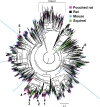The giant pouched rat (Cricetomys ansorgei) olfactory receptor repertoire
- PMID: 32240170
- PMCID: PMC7117715
- DOI: 10.1371/journal.pone.0221981
The giant pouched rat (Cricetomys ansorgei) olfactory receptor repertoire
Abstract
For rodents, olfaction is essential for locating food, recognizing mates and competitors, avoiding predators, and navigating their environment. It is thought that rodents may have expanded olfactory receptor repertoires in order to specialize in olfactory behavior. Despite being the largest clade of mammals and depending on olfaction relatively little work has documented olfactory repertoires outside of conventional laboratory species. Here we report the olfactory receptor repertoire of the African giant pouched rat (Cricetomys ansorgei), a Muroid rodent distantly related to mice and rats. The African giant pouched rat is notable for its large cortex and olfactory bulbs relative to its body size compared to other sympatric rodents, which suggests anatomical elaboration of olfactory capabilities. We hypothesized that in addition to anatomical elaboration for olfaction, these pouched rats might also have an expanded olfactory receptor repertoire to enable their olfactory behavior. We examined the composition of the olfactory receptor repertoire to better understand how their sensory capabilities have evolved. We identified 1145 intact olfactory genes, and 260 additional pseudogenes within 301 subfamilies from the African giant pouched rat genome. This repertoire is similar to mice and rats in terms of size, pseudogene percentage and number of subfamilies. Analyses of olfactory receptor gene trees revealed that the pouched rat has 6 expansions in different subfamilies compared to mice, rats and squirrels. We identified 81 orthologous genes conserved among 4 rodent species and an additional 147 conserved genes within the Muroid rodents. The orthologous genes shared within Muroidea suggests that there may be a conserved Muroid-specific olfactory receptor repertoire. We also note that the description of this repertoire can serve as a complement to other studies of rodent olfaction, as the pouched rat is an outgroup within Muroidea. Thus, our data suggest that African giant pouched rats are capable of both natural and trained olfactory behaviors with a typical Muriod olfactory receptor repertoire.
Conflict of interest statement
The authors have declared they have no competing interests.
Figures






Similar articles
-
Spontaneous Pituitary Neoplasm in Two Female Geriatric Southern Giant Pouched Rats (Cricetomys ansorgei).Comp Med. 2023 Dec 1;73(6):486-493. doi: 10.30802/AALAS-CM-23-000051. Comp Med. 2023. PMID: 38217070 Free PMC article.
-
Chromosome-scale genome assembly of the African giant pouched rat (Cricetomys ansorgei) and evolutionary analysis reveals evidence of olfactory specialization.Genomics. 2022 Nov;114(6):110521. doi: 10.1016/j.ygeno.2022.110521. Epub 2022 Nov 8. Genomics. 2022. PMID: 36351561
-
Rapidly training African giant pouched rats (Cricetomys ansorgei) with multiple targets for scent detection.Behav Processes. 2020 May;174:104085. doi: 10.1016/j.beproc.2020.104085. Epub 2020 Feb 14. Behav Processes. 2020. PMID: 32068141
-
Co-regulation of a large and rapidly evolving repertoire of odorant receptor genes.BMC Neurosci. 2007 Sep 18;8 Suppl 3(Suppl 3):S2. doi: 10.1186/1471-2202-8-S3-S2. BMC Neurosci. 2007. PMID: 17903278 Free PMC article. Review.
-
Odorant receptor genes in humans.Curr Opin Genet Dev. 1999 Jun;9(3):315-20. doi: 10.1016/s0959-437x(99)80047-1. Curr Opin Genet Dev. 1999. PMID: 10377291 Review.
Cited by
-
Characterization of oxytocin and vasopressin receptors in the Southern giant pouched rat and comparison to other rodents.Front Endocrinol (Lausanne). 2024 May 13;15:1390203. doi: 10.3389/fendo.2024.1390203. eCollection 2024. Front Endocrinol (Lausanne). 2024. PMID: 38803478 Free PMC article.
-
Tracking the Diversity and Chromosomal Distribution of the Olfactory Receptor Gene Repertoires of Three Anurans Species.J Mol Evol. 2023 Dec;91(6):793-805. doi: 10.1007/s00239-023-10135-y. Epub 2023 Oct 31. J Mol Evol. 2023. PMID: 37906255
-
Spontaneous Pituitary Neoplasm in Two Female Geriatric Southern Giant Pouched Rats (Cricetomys ansorgei).Comp Med. 2023 Dec 1;73(6):486-493. doi: 10.30802/AALAS-CM-23-000051. Comp Med. 2023. PMID: 38217070 Free PMC article.
-
Expansion and Accelerated Evolution of 9-Exon Odorant Receptors in Polistes Paper Wasps.Mol Biol Evol. 2021 Aug 23;38(9):3832-3846. doi: 10.1093/molbev/msab023. Mol Biol Evol. 2021. PMID: 34151983 Free PMC article.
-
MRI tractography reveals the human olfactory nerve map connecting the olfactory epithelium and olfactory bulb.Commun Biol. 2022 Sep 6;5(1):843. doi: 10.1038/s42003-022-03794-y. Commun Biol. 2022. PMID: 36068329 Free PMC article.
References
Publication types
MeSH terms
Substances
LinkOut - more resources
Full Text Sources

